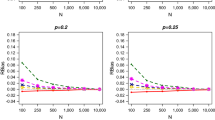Abstract
A unified approach is suggested to estimate the population size for a closed population in discrete time. Individuals can be removed after capture at any time during the experiment. The usual recapture and removal experimentsare shown to be particular cases of the general formulation. The capture probability is assumed to have a logistic function that depends on individual covariates and can be time dependent. The unified approach involves a two-step procedure. A conditional likelihood function is used to estimate the covariates coefficients and a Horvitz-Thompson type estimator to estimate the population size. The asymptotic and small-sample properties of the resulting estimators are in vestigated. A real example is given.
Similar content being viewed by others
References
Andersen, P. K., Borgan, O., Gill, R. D., and Keiding, N. (1993), Statistical Models Based on Counting Processes, New York: Springer-Verlag.
Burnham, K. P., and Overton, W. S. (1978), “Estimation of the Size of a Closed Population When Capture Probabilities Vary Among Animals,” Biometrika, 65, 625–633. Correction, 68, 345.
Carothers, A. D. (1973), “The Effects of Unequal Catchability on Jolly-Seber Estimates,” Biometrics, 29, 79–100.
Chao, A. (1987), “Estimating the Population Size for Capture-Recapture Data With Unequal Capturability,” Biometrics, 43, 783–791.
Chao, A., and Lee, S. M. (1992), “Estimating the Number of Classes via Sample Coverage,” Journal of the American Statistical Assocition, 87, 210–217.
Cormack, R. M. (1968), “The Statistics of Capture-Recapture Methods,” Oceanography and Marine Biology: An Annual Review, 6, 455–506.
Cox, D. R., and Hinkley, D. V. (1974), Theoretical Statistics, London, Chapman and Hall.
Horvitz, D. G., and Thompson, D. J. (1952), “A Generalization of Sampling Without Replacement From a Finite Universe,” Journal of the American Statistical Association, 47, 663–685.
Huggins, R. M. (1989), “On the Statistical Analysis of Capture Experiments,” Biometrika, 76, 133–140.
— (1991), “Some Practical Aspects of a Conditional Likelihood Approach to Capture-Recapture Models,” Biometrics, 47, 725–732.
Huggins, R. M., and Yi, P. S. F. (1997), “Statistical Analysis of Removal Experiments With the Use of Auxiliary Variables,” Statistica Sinica, 7, 705–712.
Lee, S. M., and Chao, A. (1994), “Estimating Population Size via Sample Coverage for Closed Capture-Recapture Methods,” Biometrics, 50, 88–97.
Lloyd, C., Yip, P. S. F., and Chan, K. S. (1998), “A Comparison of Recapturing, Removal and Resighting Designs for Population Size Estimation,” Journal of Statistical Inference and Planning, 71, 363–373.
Manly, B. F. J. (1970), A Simulation Study of Animal Population Estimation Using the Capture-Recapture Method,” Journal of Applied Ecology, 7, 13–39.
Nayak, T. K. (1988), “Estimating Population Size by Recapture Sampling,” Biometrika, 75, 113–120.
Otis, D. L., Burnham, K. P., White, G. C., and Anderson, D. R. (1978), “Statistical Inference From Capture Data on Closed Animal Populations,” Wildlife Monograph, 62, Washington, DC: The Wildlife Society.
Pollock, K. H. (1993), “Modeling Capture, Recapture and Removal Statistics for Estimation of Demographic Parameters for Fish and Wildlife Populations: Past, Present and Future,” Journal of the American Statistical Association, 86, 225–238.
Pollock, K. H., Hines, J. E., and Nichols, J. D. (1984), “The Use of Auxillary Variables in Capture-Recapture and Removal Experiments,” Biometrics, 40, 329–340.
Yip, P. S. F. (1995), “Estimating Number of Errors in a Computer Program,” IEEE Transactions on Reliability 44, 322–326.
Yip, P. S. F., Chan, K. S., and Lin, D. Y. (1996), “Regression Models for Discrete-Time Recapture and Removal Studies,” ASA Proceedings, Biopharmaceutical Section, 103–107.
Yip, P. S. F., Huggins, R., and Lin, D. Y. (1996), “An Inference Procedure for Capture-Recapture Experiments in Continuous Time With Variable Capture Rates,” Biometrika, 83, 477–483.
Author information
Authors and Affiliations
Corresponding author
Rights and permissions
About this article
Cite this article
Yip, P.S.F., Wan, E.C.Y. & Chan, K.S. A unified approach for estimating population size in capture-recapture studies with arbitrary removals. JABES 6, 183–194 (2001). https://doi.org/10.1198/108571101750524698
Received:
Accepted:
Issue Date:
DOI: https://doi.org/10.1198/108571101750524698




